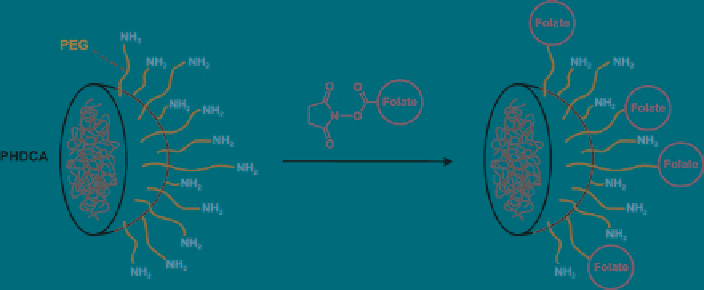Biomedical Engineering Reference
In-Depth Information
The P(HDCA-
co
-MePEGCA) copolymer was also employed for the synthesis
of PEGylated nanocapsules, either by interfacial deposition (Brigger et al.
2003
) or
by water-in-oil-in-water (w/o/w) double emulsion (Li et al.
2001a, b
) In the latter
case, water-containing nanocapsules of 140-150 nm were obtained.
4.3
Third Generation: Addressed Nanoparticles
The synthesis of efficient ligands-decorated colloidal devices for achieving specific
cells targeting, based molecular recognition processes, has become one of the most
exciting fields regarding drug delivery. Indeed, previous generations of PACA
nanoparticles were unable to be efficiently addressed to the desired cells and the
therapeutic activity of the encapsulated drug may be partly decreased.
The preparation of folate-decorated poly[(hexadecyl cyanoacrylate)-
co
-
aminopoly(ethylene glycol) cyanoacrylate] [P(HDCA-
co
-NH
2
PEGCA)] nano-
spheres (Fig.
11
) to target the folate receptor, which is overexpressed at the surface
of many tumor cells, was reported (Stella et al.
2000, 2007
). For this purpose, a
P(HDCA-
co
-NH
2
PEGCA) copolymer was synthesized and self-assembled in water
into stable 80 nm nanospheres, at the surface of which
N
-hydroxysuccinimide-
folate (NHS-folate) was reacted
via
an amidation pathway. It was shown that the
apparent affinity of the folate bound to the nanospheres towards its receptor
appeared tenfold higher than the free folate in solution, because of the multivalency
of the folate-decorated nanoparticles.
Curcumin-loaded P
n
BCA nanoparticles coated with Tween 80 (Mulik et al.
2009
) were further decorated with apolipoptotein E3 (Apo E3) (Mulik et al.
2010
).
This strategy provided efficient photostability and cell uptake of curcumin by active
targeting
via
receptor-mediated endocytosis.
In vitro
cell culture study showed
enhanced therapeutic efficacy of the curcumin-loaded Apo E3-P
n
BCA nanoparticles
against beta amyloid induced cytotoxicity in SH-SY5Y neuroblastoma cells com-
pared to free curcumin.
Fig. 11
Synthesis of poly[(hexadecyl cyanoacrylate)-
co
-aminopoly(ethylene glycol) cyanoacrylate]
[P(HDCA-
co
-NH
2
PEGCA)] copolymer
via
tandem Knoevenagel condensation-Michael addition
reaction

Search WWH ::

Custom Search